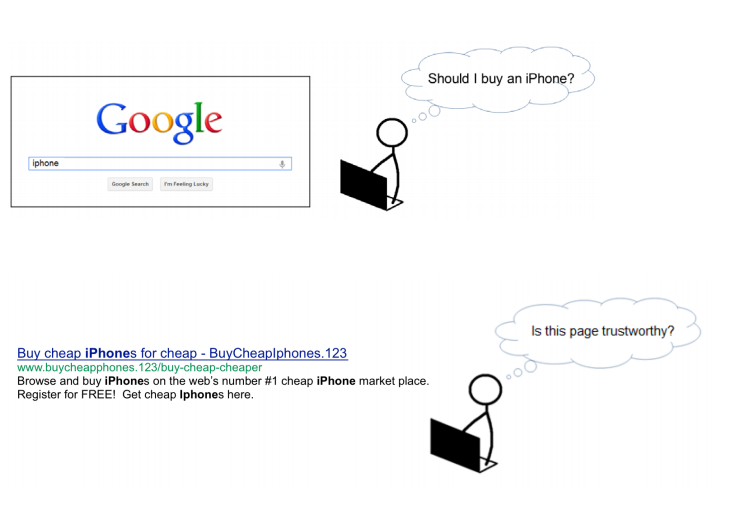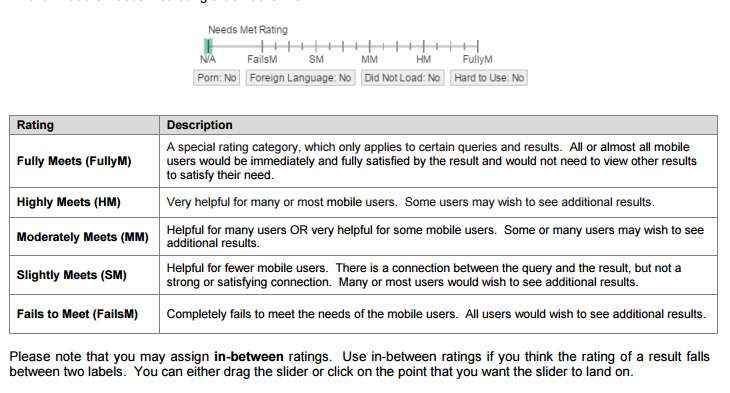The surprises from Google keep on coming. Whilst in the past, the search engine’s search quality guidelines were leaked from time to time but never in full, Google has now officially published them and made them available to download.
What are the Search Quality Rating Guidelines?
 Right from the very start, Google has been continuously developing an automatic algorithm to evaluate the quality of websites. With billions of webpages on the Internet and a simlar number of daily searches, it is impossible to carry out a manual evaluation of the quality of every single website in response to every search request. For this reason, Google constantly adjusts its algorithm via a series of 300-400 updates per year. The biggest updates are given names such as Penguin, Panda and Hummingbird, and are the updates which have had the biggest effects on search engine results. Google is always experimenting with its search algorithm and receives feedback from so-called quality raters. This feedback is passed on to Google’s development team and is taken into account when adjusting the algorithm. In order to maintain an objective evaluation of websites, the quality raters are provided with specific stipulations to guarantee a consistent definition of “quality”. These guidelines became the so-called Search Quality Rating Guidelines (or General Guidelines) and stipulate which criteria are considered important by Google when determining the “quality” of a website.
Right from the very start, Google has been continuously developing an automatic algorithm to evaluate the quality of websites. With billions of webpages on the Internet and a simlar number of daily searches, it is impossible to carry out a manual evaluation of the quality of every single website in response to every search request. For this reason, Google constantly adjusts its algorithm via a series of 300-400 updates per year. The biggest updates are given names such as Penguin, Panda and Hummingbird, and are the updates which have had the biggest effects on search engine results. Google is always experimenting with its search algorithm and receives feedback from so-called quality raters. This feedback is passed on to Google’s development team and is taken into account when adjusting the algorithm. In order to maintain an objective evaluation of websites, the quality raters are provided with specific stipulations to guarantee a consistent definition of “quality”. These guidelines became the so-called Search Quality Rating Guidelines (or General Guidelines) and stipulate which criteria are considered important by Google when determining the “quality” of a website.

Three years ago, Matt Cutts of Google’s web spam team explained in a video how Google works with its quality raters to improve the algorithm. You can view the video here:
These guidelines are of huge interest to search engines optimisers (SEOs) who rely on them to gain an impression of what criteria Google considers important when defining a qualitatively high value website, and which therefore enable a website to rank highly in Google. Google has often denied that the evaluation criteria used by the quality raters are concrete ranking factors, but this is doubted by many experts.
Search Quality Rating Guidelines broken down
The first chapter, “General Guidelines Overview”, contains an initial overview including explanations of important technical terms such as browsers, ad blockers, ant-virus software etc.
Chapter two, “Page Quality Rating Guidelines”, deals with the quality of a website. It contains criteria used by Google to differentiate between a page, a URL or a website.
A page a single document in the world wide web which can be called up by a browser. Every individual page counts when it comes to evaluation. The URL is the “address” needed by the browser to locate a document within the web. A website or site is a collection of documents which are all linked together and belong for example to a single company, organisation, phenomenon or person.
Google’s quality raters also need to evaluate individual documents and websites according to their quality. The scale used looks like this:

The scale distinguishes between nine different levels from ranging from lowest, low, medium, high to highest to categorize a website’s characteristics.
Mobile users
An increasing proportion of Google searches are conducted from mobile devices. Google reacted to this earlier this year with the Mobile Friendly Update and, in a departure from their usual style, actually announced the update in advance. If a page is not optimised for use on mobile devices, it will not rank as highly when accessed via a tablet or mobile phone. With its mobile update, Google is taking into account changing user behaviour online.
Chapter three, “Understanding Mobile User Needs”, isn’t limited to website user-friendliness (ie, responsive design or mobile optimisation) but also contains content factors. Here, Google recognises that user behaviour and user intentions and expectations are different when searching on mobile devices. Why might somebody be searching from a mobile phone? Where might they be? What sort of information might they need in response to a keyword? The needs of “mobile users” are unlikely to be the same as users sat at their PC or laptop.
The following graphic from the Guidelines conveys the message clearly:

Here, a user has searched for the keyword “apple”. But what exactly are they looking for? The company? The fruit? The name? The city in Oklahoma? Google’s challenge is to provide the user with the information they are looking for. This can vary hugely for mobile users, but it’s not universal for desktop users either.
Chapter four of the Search Quality Rating Guidelines is entitled “Needs Meet Rating Guidelines” and evaluates how accurately the websites Google displays correspond to the intentions and requirements of the user and to what extent Google provides satisfactory information. Google defines a clear scale here too:

The final chapter, “Using the Evaluation”, contains recommendations on how quality raters should use the criteria. Indications as to the evaluation of the quality fo a website which would be interesting for SEOs are not given.
Conclusion
Previously only accessible to internal quality raters, Google has now made public 160 pages of information on the internal workings of the search engine with the publication of its Search Quality Rating Guidelines. The first question on the lips of curious industry experts: why has Google suddenly changed its tune and openly posted previously sensitive information on its own blog?
Mimi Underwood, senior Program Manager, Search Growth & Analytics, explained in the blogpost that the document is not to be considered a “final version” and that there is indeed likely never to be a complete set of guidelines.
One glance at the actual contents of the document reveals that many of the quality criteria were indeed already known to (or at least strongly suspected by) industry experts. It’s also worth mentioning that the latest Google Panda Update had a lot to do with the quality of a website.
The complete Google Guidelines can be downloaded in full here as a PDF.
The graphics used in this article have been taken directly from the guidelines.
